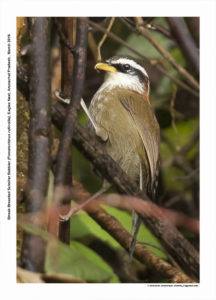
Streak breasted Scimitar-babbler Pomatorhinus ruficollis
Etymology:
- Pomatorhinus : Greek word pomatos – lid, cover; rhinos- nostrils {Lid covered nostrils}
- Ruficollis: Latin word rufus- red ; collis –necked { Red necked}
Vernacular Names: Naga: Moh-mera
They belong to the family of old-world Babblers. Their long downward curved Beak give them this name.
Distribution in India: Resident of Eastern Himalayas and North East India
Description: Size of 16–19 cm; Wt. of 19–39 g. It is a small scimitar-babbler, warm brown above with rufous-chestnut nape and neck side, pale supercilium, black mask and broad breast streaks; bill is shorter and less decurved than that of congeners. The nominate race has dull ochrous-brown crown, clear-cutting to dull rufous-chestnut nape and upper mantle, shading to warm ochrous olive-brown on remaining upperparts, upperwing and tail. The long broad supercilium is white, lores, cheek and ear-coverts are black but lower ear-coverts has some white streaks, neck side below end of supercilium and behind ear-coverts are rufous-chestnut; chin, submoustachial area and throat are white, breast and mid-belly are white with long broad dull ochrous-olive streaks, flanks, lower belly, thighs and vent are dull grey-tinged with ochrous-olive. The iris is pale red to crimson-brown or dark brown; upper mandible is black with yellow tip, lower mandible is yellow to yellowish-white; legs are greenish-grey or yellowish-plumbeous to brown. Both the sexes are similar. The juvenile is more rufous above than adult, with white throat and plain rufous-chestnut breast. Race godwini ( Arunachal pradesh) has darker crown and more rufescent upperparts than nominate, streaking below is duller; race bakeri ( North east Indian Hills, South of river Brahmaputra) has paler, weaker under part streaking, slightly paler and colder upperparts, yellow eyes, yellow bill.
Habitat: It is found in dense scrub on hillsides, dense undergrowth in open forest, open bamboo-jungle, rhododendron shrubs, brambles, bracken, tea gardens and jungle edge, thickets, hedges, and cogon grass. It is found from 900 -3000 m.
Food Habits: They feed on Insects, including cicadas, beetles, ants, larvae and grubs; also seeds and berries. It forages near ground. It climbs about tree trunks; also hangs upside-down, like woodpecker or nuthatch on underside of moss-covered branch.
Breeding Habits: They breed from Jan–Jul; multi-brooded. The nest is a bulky, crude dome with entrance at side or near top, or a cone on its side, made of dry bamboo or other leaves, fern leaves, grasses, strips of bark, twigs, plant fibers, stems and roots, lined with rootlets, grasses, leaf skeletons, moss, stalks and fine fibers, placed on ground among grass, ferns or dead leaves, in recess in bank or on ledge, sometimes low down in small tree, bush or grass. They lay a clutch of 2–5 eggs.